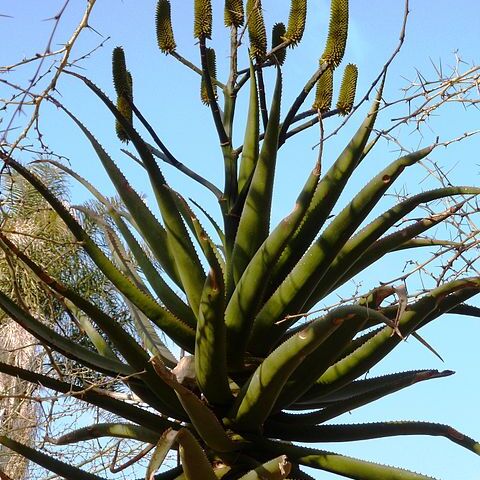Trees; stems 6-8 m tall, usually simple. Leaves 30-40, erect to recurved, 300-750 x 35-100 mm, channelled, deep green, without surface prickles. Inflorescence with 12-18 racemes, 1.0-1.3 m tall; racemes very dense, cylindric; bracts oblong, 1-2 x 2-3 mm. Flowers orange-yellow in bud, lemon at flowering, 15-20 mm long, cylindric-ventricose; outer segments connate in lower half, inner segments free but dorsally adnate to outer for ±5-6 mm; pedicels 1-2 mm long. Anthers exserted 7-15 mm; filaments vermilion. Ovary 4-5 x 2-3 mm, green; style deep orange, exserted 7-20 mm. Fruit not seen.
Leaves in a compact rosette at the stem apex, spreading becoming recurved; lamina up to c. 70 cm long, 7–10 cm wide at the base, lanceolate-attenuate, deeply channelled, dull dark green, without spots; margin reddish, with pungent deltoid reddish-brown teeth 3–5 mm long and 10–15 mm apart.
Perianth orange-yellow opening to lemon-yellow, 18–20 mm long, c. 4 mm in diameter across the ovary, widening to c. 7 mm at the middle and narrowing slightly toward the mouth, cylindrical-ellipsoid; outer segments free for c. three-quarters, with tips slightly spreading.
Inflorescences 1–2, erect to 1.25 m tall above the leaf rosette; peduncle stout, 6–9-branched, the lower branches rebranched; branches spreading upwards, subtended by brown scarious deltoid bracts 5 × 10 mm, with scattered sterile bracts below the racemes.
A small tree. It grows 8 m tall. The stem is 20 cm across. The leaves are in a compact ring at the top of the plant. The leaves are 70 cm long by 7-10 cm wide.
Racemes erect, up to 25 × 7 cm, cylindric, very densely flowered; bracts 2 × 4 mm, rounded, scarious, buff-coloured, reflexed; pedicels c. 1 mm long.
Stamens and stigma exserted c. 15 mm; stamens with filaments reddish-orange, anthers orange, stigma orange.
Stem simple, with withered leaf remains clothing the upper part, naked on the lower part.
Small tree, up to 8 m high.
Capsule and seeds not seen.


